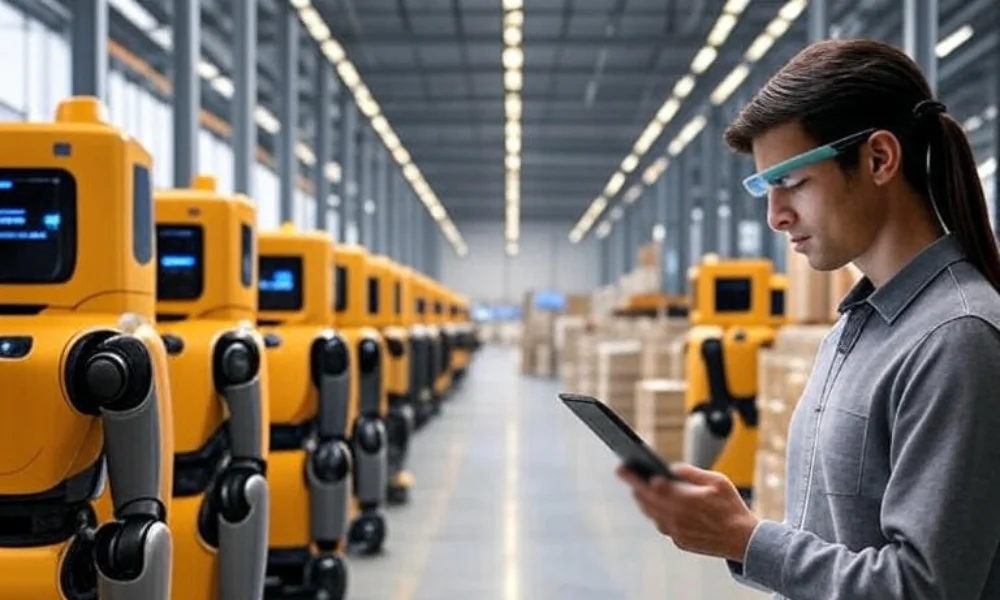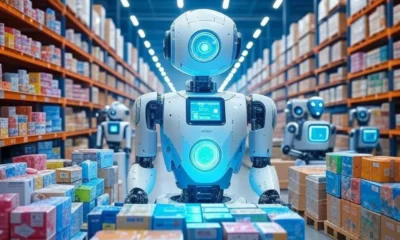Artificial Intelligence
ML algo for Order:
Machine learning algorithms are transforming how warehouses pick orders by making processes faster and more accurate. In this article, I explain how these smart technologies optimize routes and reduce errors to save time and money.

Once you’ve managed a busy warehouse, like I have, you quickly notice how slow and inaccurate order picking can get frustrating. I feel that outdated methods won’t manage what we face today, quick deadlines and greater expectations from our customers.
Definition:
Order picking involves taking goods from a warehouse to ship them to customers as requested.
I’ll explain how these algorithms have made the process of order picking much more efficient. In this article, I’ll present actual examples and explain how these technologies can simplify your work.
What Does Order Picking Involve in a Warehouse?
- I was surprised when I learned that a lot of time in warehouses goes toward picking orders.
- Order picking means finding items in storage to send to customers for their orders in a fast and accurate way.
- At first, it looks straightforward, but it is in fact one of the toughest parts of running a warehouse.
- I’d like to briefly explain the main picking systems I have observed in businesses of all scales:
- Picking specific items required in one order.
One staff member handles just one order at a time which makes this method best for warehouses with a low number of moving parts.
Batch Picking:
It’s been helpful to use batch picking whenever orders share the same things, as it speeds up the picking process.
Zone Picking:
Workers work in different zones, taking products only from those zones.
Wave Picking:
If it is important to have fast and coordinated picking, wave picking allows us to group picks of products in set waves for shipping quicker. Even with all these techniques, many warehouses deal with the same difficulties that make it hard to be efficient and profitable.
High labor expenses in the industry:
Manual order picking costs over half of what companies pay their logistics team and this cost increases with time.
Picking Errors:
If picks are flawed, customers are sent the wrong items which makes them lose trust and triggers expensive returns.
Inefficient Routes:
If planning is lacking, employees end up wasting time and having to cover more ground than needed for every order they pick.
Issues in getting orders out:
A delay in picking can prevent items from being shipped andr cause frustration for everyone involved.
Why should we use Machine Learning for Order Picking?
I depended on ordinary warehouse software and it never helped when things like delays or late orders appeared. After that, I studied ways that AI machine learning could help with order picking and it was clear to me that it improved the process. Traditionally, picking followed inflexible rules, but with machine learning, it is improved by using previous data and getting better over time.
Machine learning is more reliable for me since it can face change more effectively than programs with fixed rules. Should a new product catch on, the system handles the change in picking route on its own, without my needing to do anything. It shows common purchases and which employees work more efficiently in particular locations.
I’d like to explain a few reasons why machine learning works better than manual picking.
It adapts itself as time goes on:
Unlike other systems, ML can alter pickers’ routes based on live data to save them from unneeded travel.
It makes predictions more accurate:
The system often cuts down on picking errors by studying how workers make mistakes and correcting itself to avoid the next time.
It helps you save:
Using computer routing, fewer hours and checking for errors led to a big drop in my running expenses.
How can Machine Learning Improve the Order Picking Process?
My first experience with machine learning didn’t lead me to believe there would be so much assistance with warehouse picking. Suitability of an algorithm depends on the warehouse’s size and the pattern of orders you receive. Allow me to talk about the top useful ones I either tried or heard about from operating missions.
1. Classification Algorithms:
Thanks to these algorithms, the most popular products are stored where they are easi. I trained decision trees and random forests to label high-frequency SKUs which increased both speed and accuracy in picking.
2. Clustering Algorithms:
Clustering involves bringing closely matched items or orders together so that you can grab them all using fewer trips. Using K-Means and DBSCAN, I found out which items typically appear together in one order, helping batch picking become more effective.
3. Reinforcement Learning:
I ran a sequence of experiments with Q-learning and deep Q-networks, each training for a period to determine the quickest and most efficient routes to pick products.
4. Neural Networks:
Neural networks are able to predict the size of orders, expected demand or identify items with vision. At high-volume warehouses, I used LSTM to see when the biggest order volumes were likely to happen, helping our team plan for those days.
5. Genetic Algorithms:
These methods guide you to the most efficient combination of routes or to properly scheduling the pickers. I once tested a genetic algorithm for pick routes and noticed that the workers had to walk 20% less during every shift. Every one of these helps to cut picking delays and raise warehouse efficiency without spending on additional labor.
Where Can We Find Machine Learning Algorithms at Work in Real Warehouse Settings?
I found out that as I learned more about success stories, the theory behind machine learning plays a big role in powering real-time warehouses.
Evidence from Amazon, Ocado and Zebra Technologies has documented the boost in pick rate that comes from using machine learning.
I’ve looked at some cases that reveal how machine learning is put into practice.
1. Watch out for Kiva Robots from Amazon:
Kiva robots at Amazon help humans by delivering the shelves to them, rather than making the pickers run across the warehouse. With reinforcement learning, these robots help travelers find quickest routes which saves humans more than 70% of their previous travel time.
2. Ocado has created a revolutionary warehouse:
Thousands of robots in Ocado’s UK warehouse are all guided and coordinated by machine learning technology. System groups orders, forecasts how much is needed and updates pick routes instantly to ensure operations do not stop.
3. Predictive Picking from Zebra Technologies:
By joining information from handheld scanners with ML, Zebra Technologies improves warehouse picking and lowers wait times. I’ve come across information on how they predictive what users want and then arrange the warehouse to make things more efficient.
These studies confirm that you don’t need to be a major tech company to use machine learning for order picking.
What Can Machine Learning Offer to Order Picking?
After I added machine learning to my order picking system, I immediately observed its rewards. It wasn’t only about how quickly things moved, it made everything across the warehouse easier and more precise, with fewer workers involved.
I am happy to share the actual warehouse benefits I noticed when starting to use machine learning in order picking.
1. There is a rise in the number of accurate picks:
Most of the mistakes I made were in the busiest shifts, but with machine learning, I was able to rectify about half of them. With every mistake analyzed, the system helped us make decisions with greater certainty.
2. Cut Back on Operating Costs:
After I introduced better picking routes, my team needed to walk less and worked more smoothly, so both time and money were saved. Because the system worked well, I didn’t need to hire additional seasonal staff to handle the increased orders.
3. Improved Time for Completing Orders:
Customers care about how fast they receive their orders and with machine learning, I was able to deliver faster without increasing rush for my team. As a result, pickers were able to walk shorter paths, select items by grouping and finish the job without spending much time moving back and forth.
4. Increased Worker Performance:
When I optimized routes, I could tell workers felt less stressed and more productive, exactly how I wanted it in the warehouse. Because there was no need to look for products, my group handled more orders much faster.
5. Improved Efficiency in Inventory:
Machine learning models told me which products were most popular, allowing me to keep the right amount and avoid oversupply of others.
Because of this, I used my warehouse space better and made sure the most popular items were well-stocked.
What helped me was seeing that the system continued to improve and grow during the time I was away from the computer.
What Points Should I Study Before Using Machine Learning in My Warehouse?
Once I began using machine learning in order picking, I saw that early planning solved everything. Before starting, I needed to think about my data, systems and the setup of my warehouse. Allow me to explain what I learned in that situation, so you know how to begin properly as well.
1. What Data Should I Use?
What data your machine learning uses determines its success, so I took care to ensure mine was clean. Data included understanding items’ locations, prior orders, the number of SKUs and the time it took to complete every pick. If your data is not clear or some material is missing, I suggest you begin with fundamental warehouse tracking AI tools to make your data better.
2. Will It Fit Seamlessly with Technology I Have in Place?
Being that my warehouse is already using a WMS, I needed to verify that the model is compatible with it. It is thankfully easy now, because most ML tools can either connect with WMS or operate in the cloud with easy-to-use APIs.
3. What Kinds of Problems Are Found Most Frequently?
It was hard to convince my team to use the new system, they had to adapt and go through training first. I discovered that spending more is common, since custom options and good sensors for automation can be quite pricy. Money saved from doing pickups more accurately and efficiently justified the investment, in my point of view.
Ensure you have the right information, the proper tools and a positive attitude for machine learning projects, this will help the process.
Where Is Machine Learning Headed in the Process of Order Picking?
It looks like machine learning is making order picking more intelligent and cheap for warehouses of all types. It used to be that large companies were the main users of AI, but we are able to use them too now. The focus in the future is on automation, smart choices and quicker fulfillment using less effort and making fewer mistakes.
1. Real-Time Learning in Smarter Robots:
Robots are getting education while they work, rather than beforehand. I’ve come across reports that now, robots can adapt to the best route while working. With reinforcement learning, they constantly adjust their activities and pick orders more quickly during every shift.
2. This technology relies on Predictive Warehousing Systems:
I think soon, inventory systems will be able to anticipate and respond to changes in demand ahead of time. If you imagine software moving items quickly when they’re most needed during peak seasons that is now possible with machine learning.
3. Tools Supporting Workers with AI Technology:
Automating everything in a warehouse is not always possible, yet I have seen smart glasses and wearable tech direct human employees while they pick items.
We will soon find machine learning in almost everything we do. If you don’t start thinking about retirement now, you might find it harder later.
Conclusion:
I have realized machine learning is having a major impact on how orders are picked in warehouses. Fulfillment happens faster and cheaper when route optimization, reduced mistakes and adaptive processes are applied by these technologies. If you have any responsibilities in a warehouse, examining machine learning can be your best decision in 2023.
What has proven to be the most difficult about order picking for you? How much machine learning do you use in your warehouse at present?
If you want to share what you learned here or ask a question, you are welcome to write it in the comments.
-

 Artificial Intelligence8 months ago
Artificial Intelligence8 months agoWhat is Artificial Intelligence? A Comprehensive Guide for Businesses and Enthusiasts
-

 Artificial Intelligence6 months ago
Artificial Intelligence6 months agoHow to Use Grok AI: A Complete Guide
-

 Artificial Intelligence8 months ago
Artificial Intelligence8 months agoUnlocking the Power of Artificial Intelligence Tools
-

 Artificial Intelligence7 months ago
Artificial Intelligence7 months agoWhat is DeepSeek? Revolutionizing AI with Cutting-Edge Solutions
-

 Artificial Intelligence3 months ago
Artificial Intelligence3 months agoAI Technologies in Warehouse Automation:
-

 Artificial Intelligence4 months ago
Artificial Intelligence4 months agoMeta’s AI Push: The Standalone Assistant App Set to Rival ChatGPT
-

 Artificial Intelligence3 months ago
Artificial Intelligence3 months agoHow Artificial Intelligence is Revolutionizing Logistics:
-

 Artificial Intelligence3 months ago
Artificial Intelligence3 months agoPredictive Analytics for Demand Forecasting:



JiliOK
05/25/2025 at 8:37 AM
The integration of AI in platforms like Jilivip is reshaping how players engage with games, blending tradition with innovation in modern gambling culture.